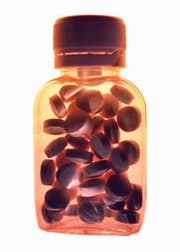
Note: This post was updated on 11/24/2013 to correct a typo in the temperatures required to isomerize fats.
Q. How exactly is trans fat created? If I bake with some (say, 1/4 cup) oil in a batter, does that make trans fats?
A. We’ve all read a lot about the dangers of trans fats. Most of the trans fat in our diet comes from artificially hydrogenated oils that are still widely used in food manufacturing. These “Franken-fats” are polyunsaturated fatty acids (PUFAs) that have been twisted into an unnatural configuration called a trans-isomer. This means that the molecule contains the exact same number and type of atoms as it did before, but they are arranged in a different shape.
But what a difference that small change makes! Polyunsaturated fats and their trans-isomers produce completely opposite effects in the body. While PUFAs help to improve cholesterol profiles and reduce your risk of heart disease, trans fats contribute to heart disease by fueling inflammation, raising bad cholesterol and lowering good cholesterol. Continue reading “Does Cooking With Oil Create Trans Fats?” >
 Recently, a reader forwarded me a link to a book about a diet that supposedly would cure type 2 diabetes. “My mom is a type 2 diabetic,” she wrote, “but I find it hard to believe that you can reverse it.” So, is this book for real? Can type 2 diabetes really be reversed with a diet? I take a closer look in this week’s show.
Recently, a reader forwarded me a link to a book about a diet that supposedly would cure type 2 diabetes. “My mom is a type 2 diabetic,” she wrote, “but I find it hard to believe that you can reverse it.” So, is this book for real? Can type 2 diabetes really be reversed with a diet? I take a closer look in this week’s show.
 Q. Makers of coconut sugar claim that it has a low glycemic index and is high in potassium and some other minerals. Would using coconut sugar make my cookies the healthiest on the block?
Q. Makers of coconut sugar claim that it has a low glycemic index and is high in potassium and some other minerals. Would using coconut sugar make my cookies the healthiest on the block?
 I was just reading a very interesting article on the safety of imported foods. Unfortunately, the publication (ADA Times) is for members of the
I was just reading a very interesting article on the safety of imported foods. Unfortunately, the publication (ADA Times) is for members of the  Q. I’ve read a lot about the health benefits of Vitamin D. But isn’t there also a limit of how much Vitamin D I should supplement? Is there a danger or limit that avoids a possible toxic amount?
Q. I’ve read a lot about the health benefits of Vitamin D. But isn’t there also a limit of how much Vitamin D I should supplement? Is there a danger or limit that avoids a possible toxic amount?